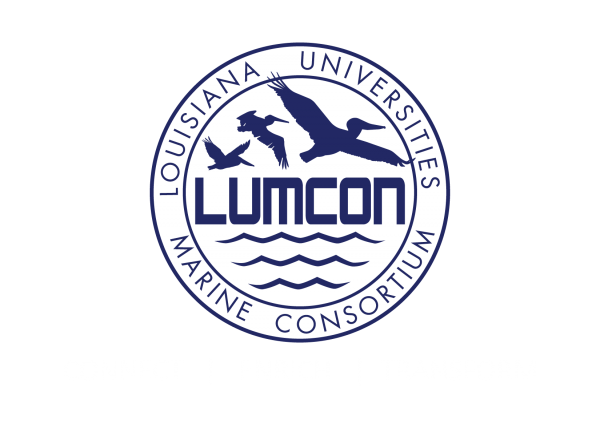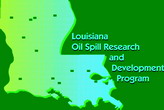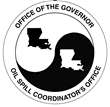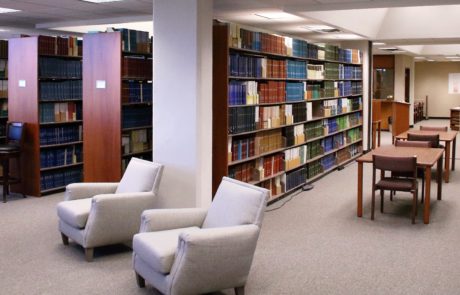LIBRARY
MAIN CATALOG (Electronic Resources/LUMCON Library)
Click here to search the Dispersants Bibliography
Click here to search Effects of Offshore Oil and Gas Development Bibliography
ABOUT THE LIBRARY
The LUMCON Library collection was originally housed in Ellender Memorial Library, located at Nicholls State University in Thibodaux, Louisiana. After completion of the DeFelice Marine Center in 1986, the collection was moved to its present location. Since that time, the Library has become an active resource center for LUMCON faculty and staff as well as Consortium member institutions, visiting researchers, students, and the public.
The library contains a computer lab and several study spaces available to visiting students, scientists, or groups (such as attendees of a writing retreat).
The collection and development of library materials reflects LUMCON’s research programs. The collection has approximately:
- 4,600 monographs
- 5,800 bound volumes
- 200 journal titles
- 26 current journal subscriptions
- 850 maps
- 35 atlases
- 3,600 government documents
- 1,500 reprints
In addition, the library houses a complete collection of research products generated by DeFelice Marine Center personnel since LUMCON’s inception.
HOURS OF OPERATION
- The LUMCON Library is staffed Monday through Friday from 7:00 AM to 3:30 PM. All visitors are welcome during these hours.
- The Library is closed to the public on weekends, state holidays, and when the librarian is not on site. Before visiting the facility, please call 985-851-2875 to ensure the Library will be open.
- All LUMCON staff, summer students, and resident visitors have 24-hour access to the Library. If the doors to the Library are locked, the security guard will open them for you.
CIRCULATION
- Books can be checked out by filling out a card at the circulation desk. The length of time a book can be checked out varies depending on the patron’s status. Books may be renewed by contacting the department, but all items are subject to recall at any time.
- Interlibrary loan service is available for LUMCON faculty, postdocs, lab personnel, and summer students. Although we strive to get items at no charge, the patron may be asked to pay for interlibrary loan charges under certain circumstances.
- Reserve items, reference materials, and journals must remain in the Library. The Library has no photocopier, but copies or scans can be made in the LUMCON main office.
- All materials must be checked out before removal from the Library, without exception.
- Library materials can be placed on reserve for summer classes. A list of items to be placed on reserve should be provided to the librarian as soon as possible.
- When returning material that has been checked out, please drop off items at the circulation counter.
Food is not allowed in the Library under any circumstance. Drinks are only allowed with prior approval by the librarian or the security guard.
INTERNSHIP PROGRAM
The LUMCON Library is available as an internship site for graduate-level students who have completed at least two semesters toward a Master’s degree in Library and Information Science. Applications will be accepted on a continuing basis and internships may be completed during any semester. Prior library experience or an undergraduate degree in science is desirable, but not necessary. Credits will be awarded based on the number of person-hours completed (40 person-hours per credit hour).
The internship will consist of both field experience, encompassing many operations of a special library, and a special project in technical services. The Librarian will give the intern an overview of reference services, technical services, library administration, and budgeting, and will guide the intern through special projects. The LUMCON Library uses SIRSI/Dynix’s Symphony Integrated Library System as well as OCLC for Cataloging/Interlibrary Loan services.
Contact the Librarian for more information or to apply for an internship.
ACKNOWLEDGMENTS
We would like to thank the following individuals for their guidance and input when creating the Dispersants Bibliography:
-
- Victoria Broje, Per Daling, Alun Lewis, and Francois-Xavier Merlin offered valuable assistance in the early phases of this project. Per Daling’s support was especially noteworthy, by providing conference proceedings that otherwise could not be obtained.
- Deborah Ansell, ITOPF’s librarian, contributed by sharing her sizeable list of library holdings on dispersant publications with us, and filling in gaps where existing citation information was incomplete.
- Likewise, Julie Anne Richardson, librarian for Environment Canada, compiled a publication listing on dispersants housed in her collection, which provided us with additional citations for our project.
- Qianxin Lin at Louisiana State University provided API conference proceedings for us to use in transcribing abstracts.
- Nancy Kinner at the Coastal Response Research Center provided encouragement, focus, and connected us with some of the aforementioned people.
- Finally, Don Davis and Karen Reeder Emory at OSRADP deserve special mention for all of their help and direction during the span of this project.
 |
 |
 |
The LUMCON Library is a member of the International Association of Aquatic and Marine Science Libraries and Information Centers (IAMSLIC), the Southeast Affiliate of IAMSLIC Libraries (SAIL), and the Louisiana Library Network and Information Consortium (LOUIS). Additionally, the Library has access to OCLC Cataloging/Interlibrary loan services.
Click here to search LUMCON’s e-Library catalog using the LOUIS portal.
DISPERSANTS BIBLIOGRAPHY
Oil and oil/dispersant mixtures were tested in field and laboratory tests to determine toxicity in copepods. Compared to oil exposures, dispersed oil (1:10 dispersant/oil combinations) had more pronounced effects on the organisms in the laboratory, with 20 hour LT50 values for direct contamination and 55 hour LT50 rates for indirect contamination of sediments. In field experiments, introduction of dispersed oil caused initial reductions in numbers of organisms, followed by a relatively swift recovery. Normal numbers were reestablished in 27 days, as opposed to 66 days for undispersed oil. Juvenile copepods appeared to be more seriously affected by exposure than adults
Over the course of several months, two areas with separate sedimentary structures (one muddy and the other consisting of fine sand) were used to monitor the effects of oil/dispersant mixtures on nematodes. In the muddy area, the oil/dispersant mixture was found to affect only Laimella longicaudata, a species sensitive to crude oil. The sandy area resulted significant decreases in nematodes were seen at the surface layer (0-1 cm), middle (1-2 cm) and deep (2-4 cm) layers. At the surface, three of the commonest species (Ascolaimus elongates, Metachromadora vivipara and Paracanthonchus caecus) were reduced, with a rare species (Daptonema riemanni) becoming most abundant, possibly migrating up from deeper layers of sediment
Recent changes in legislation within the United Kingdom created pressure for change in the response strategies applicable in the UK offshore environment. To meet the new requirements, innovative technology was required which was capable of speedily delivering a payload of approximately one ton dispersant. To provide a cost efficient solution, a system was developed capable of being mounted on a non-dedicated aircraft, which can be rapidly adapted to meet the response requirements. This paper describes the design criteria for the system and goes on to detail the development, construction and flight testing programme for the development, construction and flight testing programme for the dispersant pods. It then goes on to briefly describe the operational response system which has been established to provide a response of the offshore operators in the United Kingdom Continental Shelf (UKCS). The development represents a significant step forward in providing a low cost, effective solution to changing response requirements using innovative engineering solutions, allowing for potential application in other parts of the world
Aerial dispersant is a major response tool that is used throughout the world and continues to gain acceptance even in those countries that previously were completely opposed to it. Pressure is mounting in certain areas of the world to extend the window of opportunity of dispersant use to 24-hour operations. The paper reviews the practical problems of night use of aerial dispersant delivery systems, and identifies systems and assesses potential performance. It addresses the issues of the safety of low-level operation of spray aircraft at night, the reduction of efficiency of night spraying, and how to overcome some of the problems. It examines the protocols and procedures that must be developed as a safety check on any such operations to reduce the risks. Considering the overall risks and rewards, the final question is posed: Is the nighttime use of aerial spraying aircraft a realistic, safe, and effective response to an oil spill, or should the aerial application of dispersants be considered a daytime-only activity
In these experiments, the toxicities of Corexit 9527 and Superdispersant-25 were compared over a range of species including the amphipod Corophium volutator (Pallas), the common mussel Mytilus edulis (L.), the anemone Anemonia viridis (Forskål), and the seagrass Zostera marina (L.). LC50, EC50, and lowest-observable-effect concentration (LOEC) values were obtained after 48-h static dispersant concentrations. The ability of organisms to recover for 72 h after exposure was also invesitigated. LOECs for anemones were 20 ppm, the most succeptible organism, and 250 ppm for mussels, the most resilient of the test species. Superdispersant-25 was less toxic than Corexit 9527, and its sublethal effects were more likely to be reversible after short-term exposure to marine organisms
A method for determination of Corexit 9527® in natural waters was developed to meet the demand for effective monitoring of anionic surfactant-based oil spill dispersants. Incorporating ion-pair formation with bis(ethylenediamine) copper(II), extraction of the complex into methylisobutylketone, and flame atomic absorption spectroscopy, the method is suitable for a concentration range of 2 to 100 mg/liter, with precision as low as 5% relative standard deviation for samples in the mid- to high-range. Only a small sample volume is required (10 ml), allowing rapid analysis of multiple samples and providing sensitivity in the range most required for monitoring during the first few hours after application, when toxic impacts are most probable. Sensitivity may be substantially increased for trace analysis by increasing sample volume. Overall, the method is simple, rapid, sensitive within the range required for monitoring, requires a small sample volume, and is suitable for both marine and fresh waters
Red mangrove seedlings were planted in oiled plots and growth of the plant was observed. Results indicate that regeneration is possible in spite of high pollution levels. Toxic effects were probably amplified by climatic stresses. The addition of a bioactivator and a dispersant possibly increased toxicity in the short-term, but toxic effects rapidly decreased over time
The effects of various crude oils and chemically dispersed oil on natural phytoplankton communities were tested in several experiments using marine mesocosms. Elevated algal biomass concentrations were found in most of the experiments, despite the long-term inhibition of primary productivity per unit chlorophyll. This result is due to reduced grazing upon algae as a consequence of oil-induced mortality of copepods or bivalves. A rapid succession from a diatom-dominated algae community to one dominated by microflagellates can be observed after an oil spill, owing to the more rapid exhaustion of silicate. If silicate is not being exhausted, a prolonged abundance of diatoms is observed. Treatment of oil with dispersant generally will aggravate effects, because of high dissolved oil concentrations in the water
The effects of oil or chemically dispersed oil on the functioning of phytoplankton communities are discussed with respect to the findings of mesocosm experiments using model plankton systems for model tidal flat systems. Primary production is considered in terms of nutrient economy or grazing pressure. Observations on a North Sea plankton community during an oil spill are used as field verification of the mesocosm experiments
The potential and perceived environmental risks associated with dispersant use have been addressed by many scientific studies costing millions of dollars and tens of thousands of research hours. Nevertheless, decision-makers still have many diverse and contradictory viewpoints, which can impede their ability to evaluate and reach consensus on the actual risks associated with this countermeasure. In an attempt to resolve the problem in a different way, a new approach was formulated, based on the following hypothesis: The inability to create a solid foundation for dispersant decision support is based not only on limitations to scientific information, but also on the wide differences in the way people understand and interpret this information. In other words, a critical aspect of improved decision-making for dispersants is related to good risk communication, not more natural science studies. In 1994, industry initiated a research project to test this hypothesis and define the critical risk communication factors for dispersant decision making. This paper presents a summary of the identified dispersant risk communication issues. Building upon previous papers which described the project methodology and analytical results, this paper presents the risk communication messages which need to be shared with decision-makers and the public. This information promotes a technically sound, clear, and common framework for evaluating the ecological risks associated with dispersant use in marine waters
A series of constructed ponds were used to study the effects of oil (100 ppm) and oil/dispersant mixtures (20 ppm) on freshwater biota. Oil/dispersant-treated ponds showed changes in the dominant algae when concentrations of oil were above 2 ppm in the water column. Concentrations below 2 ppm had no observed effect on the algal community. When compared to control, the oil/dispersant treated ponds had 3 times the amount of periphyton biomass, with the growth attributed to one genus. The amount of periphytic material remained in one of the oil/dispersant treatment ponds after one year, even though a second treated pond showed levels similar to control at the end of this period. Initial decreases in dissolved oxygen were noted for the water in oil/dispersant treated ponds, although DO levels rose slightly above control weeks later. In late winter, anoxic zones above the sediment were found in oil/dispersant treated ponds. In spring, these ponds had half the concentrations of nitrate ions, when compared to oil treatment and control
This paper describes the methodology of freshwater pond experiments and summarizes the findings reported in other papers published in the same issue of this journal
In a series of constructed ponds, two ponds were treated with mixture of oil (100 ppm) and dispersant (20 ppm) and monitored over one year. The treatment initially eliminated mesozooplankton populations, although levels were normalized at the end of the study. Protozoan genera Halteria and Strobilidium disappeared upon treatment, but the former reappeared by the following spring. Other protozoans either were not affected zooflagellates) or increased after treatment (thecamoebae). Surface insects were eliminated, but had recolonized the following spring. Nekton were also negatively impacted by the initial exposure of the oil/dispersant mixture
A series of spills using oil and dispersant was begun July 5, 1978 in a set of artificial freshwater ponds. Prior to the spills, the ponds had been allowed to stabilize and the water as well as a number of biological components including zooplankton, phytoplankton, bacteria, and fungi was regularly monitored. These parameters also were determined regularly after the spill as was the distribution of the stressing agents. The short-term results, encompassing the observations made for 55 days following the spills, indicate that the oil-dispersant mixture affects the zooplankton, phytoplankton, bacteria, fungi, and dissolved oxygen to a greater degree than oil alone. Also, in the oil-dispersant ponds there was an enhancement of the dissolved reactive silica values relative to the oiled and control ponds
This database consists of citations found in journals, conference proceedings, government reports and gray literature covering over 40 years of published research on oil spill dispersants. Citations were collected from 1960 through June 2008. This bibliography was compiled and edited by John Conover, Associate Librarian at LUMCON, and funded by a grant from the Louisiana Applied and Educational Oil Spill Research and Development Program (OSRADP).
EFFECTS OF OFFSHORE OIL AND GAS DEVELOPMENT BIBLIOGRAPHY
|
Quarterly Issues
|
Compilations
|
- Biology
- Ecological, anatomical, and physiological effects of oil and/or gas, Species as biomarkers, PAH uptake and bioaccumulation, etc.
- Chemistry/Geochemistry/Geology
- Biochemistry, Biodegradation, Bioremediation, Hydrocarbon degradation, Environmental sampling, Soil contamination, etc.
- Engineering/Physics
- Technological advancements in facility/equipment design and use, Spill response and recovery equipment, Physical properties of oil and gas, etc.
- Environment/Ecosystem Management/Spills
- Environmental assessment and management, Oil and/or gas spill description and analysis, etc.
- Socioeconomic/Regulation/General
- Social and economic ramifications, Politics, Governmental policy and legislation, Organizational policy, General interest, etc.
This bibliography is a quarterly compilation of current publications (citations with abstracts) from a wide variety of electronic and print information sources relating to offshore oil and gas development. It is compiled and edited by John Conover, Associate Librarian at LUMCON. Items listed may or may not be available at the LUMCON Library. Items without annotations were unavailable for perusal prior to publication.
All questions about using library facilities, locating library resources, or searching LUMCON catalogs should be directed to the Librarian.


